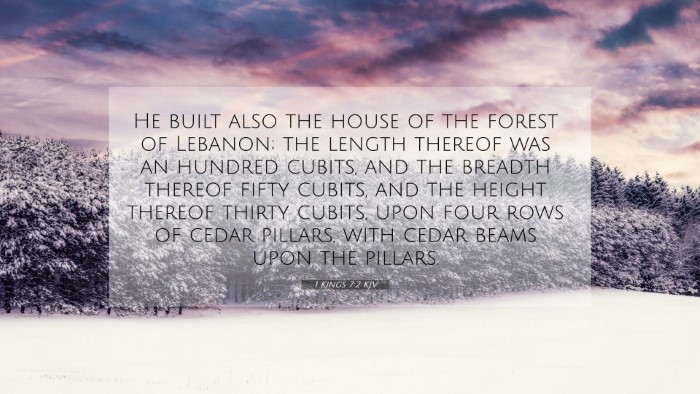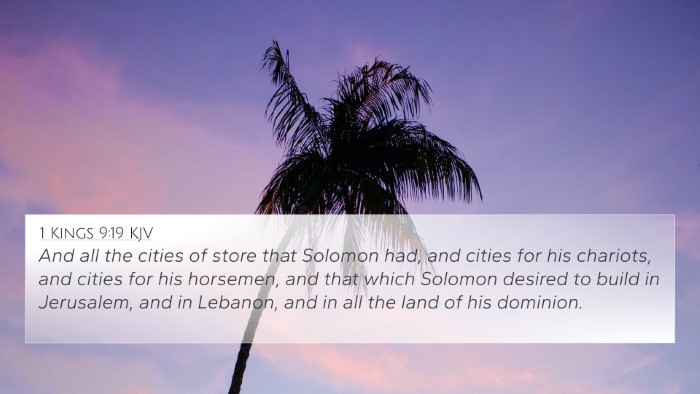Understanding 1 Kings 7:2
1 Kings 7:2 states: "He built the house of the forest of Lebanon; its length was a hundred cubits, its breadth fifty cubits, and its height thirty cubits, upon four rows of cedar pillars, with cedar beams upon the pillars." This verse describes a significant architectural feat undertaken by King Solomon—a testament to his wealth, wisdom, and the splendor of his reign.
Summary of Interpretations
The meticulous detail regarding the measurements and construction of the House of the Forest of Lebanon highlights not only Solomon’s architectural ingenuity but also serves as a symbol of strength and stability in Israel. Several public domain commentaries shed light on the implications of this passage.
Commentary Insights
Matthew Henry's Commentary
According to Matthew Henry, the House of the Forest of Lebanon exemplifies both grandeur and purpose. It was not merely an ornamental structure but also served practical functions, possibly as a storage area for Solomon's armory and as a place for the king to retreat. Henry notes that the design demonstrates Solomon's ability to integrate beauty with utility, a hallmark of wise leadership.
Albert Barnes' Commentary
Albert Barnes emphasizes the cultural significance of the materials used in the construction. The extensive use of cedar wood, particularly from Lebanon, suggests not only a connection to neighboring regions but also the wealth and resources at Solomon's disposal. Barnes points out that the design implies a connection to the ancient Near Eastern architectural styles, perhaps indicating an influence of surrounding cultures on Israelite construction techniques.
Adam Clarke's Commentary
Adam Clarke regards the dimensions of the House of the Forest of Lebanon as symbolically significant. Each measurement serves to convey a message about prosperity and divine favor upon Solomon's reign. Clarke provides insight into the practical use of the structure and notes its potential role in diplomatic relations, where Solomon received dignitaries in a setting that reflected Israel's power and affluence.
Bible Cross-References
To deepen the understanding of 1 Kings 7:2, here are several relevant cross-references:
- 1 Kings 10:17 - Discusses the use of precious materials in Solomon's reign.
- 2 Chronicles 9:20 - Connects the wealth of Solomon with the structures he built.
- Jeremiah 22:14 - Mentions construction of grand houses in Israel.
- Hebrews 3:4 - Relates to the builder of all things.
- Psalms 127:1 - Emphasizes the importance of divine involvement in building efforts.
- 1 Kings 6:9 - Provides background on materials used in Solomon's construction projects.
- 1 Chronicles 22:3-4 - Highlights Solomon’s preparation for the temple, emphasizing his wealth.
Thematic Connections
The House of the Forest of Lebanon signifies not just architectural prowess but also serves as a theme representing God's provision and the prosperity of His people. Cross-referencing this structure with the various elements of Solomon’s reign supports a narrative of divine favor and the significance of wisdom in leadership.
Conclusion
In conclusion, 1 Kings 7:2 intricately captures King Solomon's legacy through the lens of his architectural endeavors. The interpretations from various commentaries enhance our understanding of the verse's significance, emphasizing its thematic depth. The rich symbolism tied to the materials and dimensions mentioned invites readers to explore further connections, enriching the study of scriptural texts and their interrelations in the broader Biblical narrative.
Further Study
For those seeking to explore cross-referencing in the Bible, consider tools such as a Bible concordance or a Bible cross-reference guide. These resources can aid in identifying connections between different verses, enhancing your understanding of scripture through comparative study and thematic exploration.







